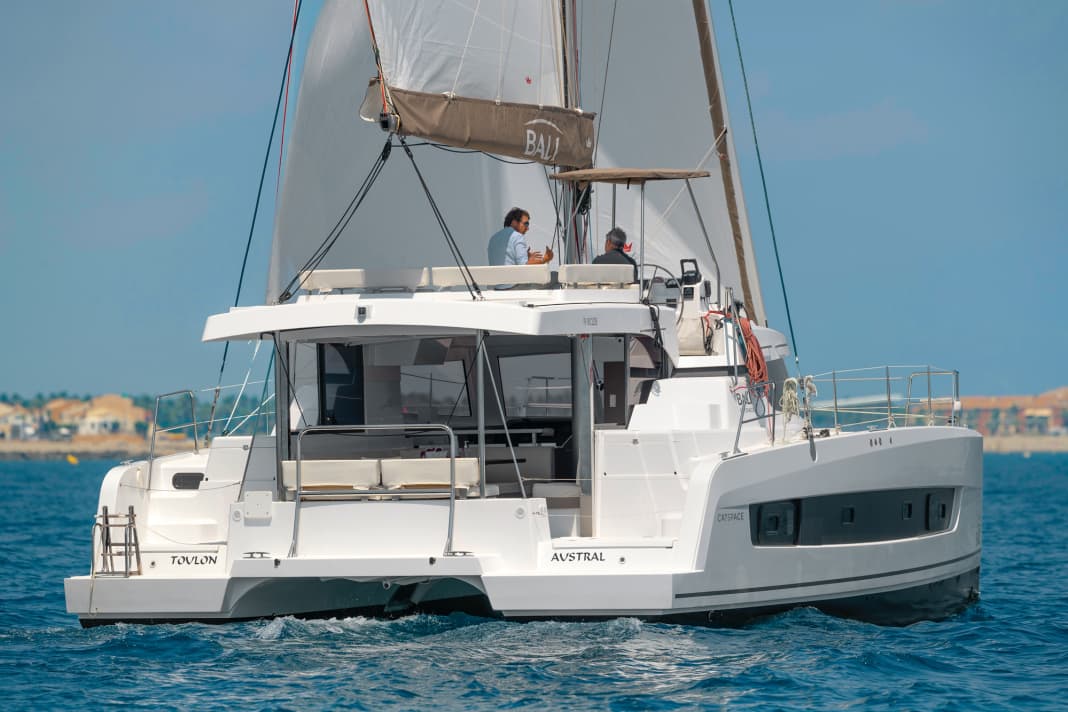





The rise of the brand can almost be described as meteoric. Bali Catamarans has only been around since 2014, but has established itself as one of the leading manufacturers in the cruising catamaran segment in just a few years. Behind the brand and its success is shipyard owner Olivier Poncin. The industry heavyweight (formerly Harmony Yachts) has developed Bali as a touring, charter and mass market offshoot of the exclusive and sporty Catana brand and integrated it into the group of companies of the same name.
Bali-Cats are laminated throughout
As the developer, Poncin has come up with an extremely unique concept for this. The outstanding speciality: the hulls of the Bali cats are laminated as a continuous platform from the stern to the bow. This means that there is no longer a trampoline between the hulls at the front, but rather a fixed structure with an integrated front cockpit. The structural cross-members, the so-called beams, can therefore be omitted on the Balis.
In the development of the Bali Catspace, Poncin has consistently utilised the associated increase in space and volume to the limits of feasibility in order to be able to install two very generously designed double cabins with wide island beds transversely at the front. Within the entry-level class with a hull length of around 40 feet (twelve metres), this is a remarkably unique selling point. In the classic catamaran concepts of the competition, the forward cabins and their berths are limited to the width of the hulls. Bali, however, wants to offer both: The French also build their entry-level model Bali 4.1 (now Bali 4.2) with a conventional layout.
More sails, more power
Another exclusive feature of the Bali Catspace is the sun lounge and the steering position on the flybridge, an amenity that no other catamaran of this size can offer. However, the luxury is combined with visual compromises. The main boom is set relatively high so as not to endanger fellow sailors on the upper floor during manoeuvres. This is not attractive and is also quite cumbersome when recovering the sails - a compromise.
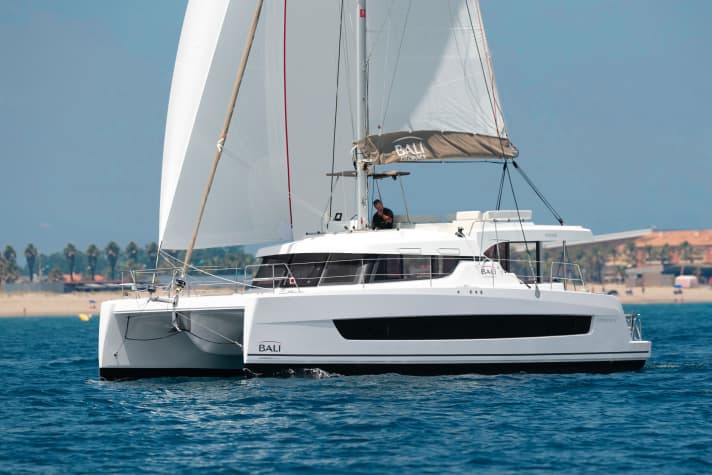
During the test in 2020 on Bali's doorstep in Canet-en-Roussillon in the south of France, there was initially only a light wind with a maximum force of 8 to 10 knots. Under standard sails (mainsail and self-tacking jib), the sailing performance remains sobering and the Catspace proves to be under-rigged. An efficient remedy here is a furling Code Zero, which provides the redeeming increase in performance from a wind angle of around 80 degrees and should actually be part of the concept and basic equipment. However, cruising in light winds is not the Catspace's speciality.
The Bali Catspace feels more comfortable in stronger winds
During the tests, however, the wind freshens up and later develops into a veritable sea breeze of up to 18 knots. The boat likes these conditions better, and is then able to impress with a pleasing performance and plenty of temperament upwind, even under jib. The log registers a speed of 6.4 knots with a tacking angle of a good 100 degrees. The compact Frenchman manages just under 8 knots over the ground with half the wind and Code Zero unfurled. The Catspace is surprisingly dynamic and agile. Turns in particular can be steered surprisingly quickly without the twin hull slowing down to a near standstill, which is usually the case with many other cats.
However, steering is not a revelation. The fully hydraulic system (standard) remains unfeeling, even with more wind and more pressure in the rig. The helmsman's work is limited to simply holding the course, which the autopilot can do at least as well. Incidentally, this is directly linked to the hydraulics of the steering system. In the event of a defect in the system, for example a leak in the hydraulic lines, the cat can only be steered with an emergency tiller.
The helm station is integrated high up in the side of the flybridge. The helmsman has a good view to all sides as well as into the sails and can see both bows and the stern on the starboard side in the harbour. However, the aft part of the port hull remains hidden.
Deckhouse with folding gate
Halyards, sheets and trim lines are, without exception, redirected to the helm station, where they are easy to operate. The arrangement of the two large sheet winches on the side of the cabin superstructure, where they can also be reached by fellow sailors standing below on the running deck, is particularly pleasing. In general, the layout of the fittings is well thought out, especially for skippers who are used to sailing the boat single-handed, even when manoeuvring. In bad weather, the Bali can also be steered from the navigation in the saloon using the remote control from the autopilot. The view forwards and to the side is also almost unrestricted from here. However, the position of the sails can hardly be controlled.
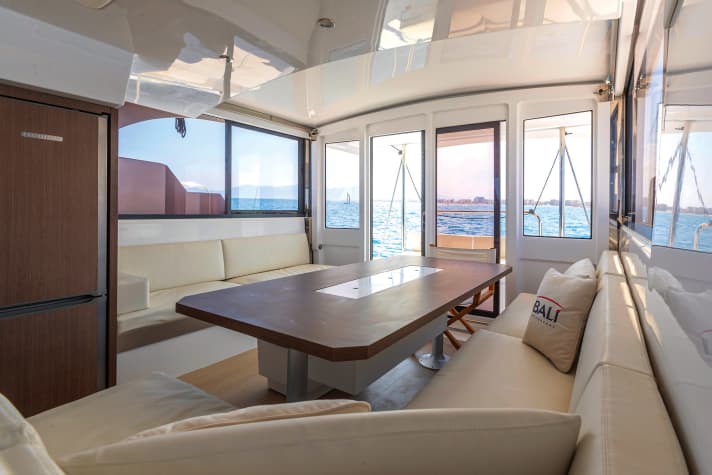
Because the platform with front cockpit is laminated through to the bow, the Catspace does away with the usual large storage spaces in the foredeck in front of the cabin superstructure. Instead, the two forepeaks provide ample storage space for all fenders, mooring lines and additional sails. There is also storage space under the seating and sunbathing areas in the cockpit, including for the life raft with a cleverly designed quick release downwards.
The large cockpit and saloon are functionally combined, with the exterior and interior forming a single unit. As with all current Bali models, the deckhouse of the Catspace can be completely closed off if required - for example in bad weather or cold weather. To do this, the sliding windows on the side and the rear wall of the deckhouse are closed. When open, this is folded up like a garage door under the fixed bimini. Pneumatically assisted, the mechanism for opening and closing the gate works perfectly.
The hulls of the Bali Catspace are manufactured in one piece
Like its brothers Bali 4.1, 4.3 and 4.6, the Catspace is manufactured in a branch of the shipyard in Tunisia. The complete hull is produced as one coherent component, manufactured using a vacuum infusion process with a PVC foam core and polyester resin. The deck, the cabin superstructure and the roof with flybridge are produced using the vacuum injection process (Resin Transfer Moulding, RTM). Although this construction method is very complex, it produces perfect surfaces, even on the inside of the laminate. This means that Bali can largely dispense with the usual inner shells when fitting out below deck and thus save weight.
The Catspace weighs 9.2 tonnes - comparatively little considering the hull undersides are completely laminated through to the ends of the ship. Incidentally, the short stub keels are only glued to the hulls, not bolted; they should fall off in the event of grounding and not damage the hull structure. Nevertheless, the keel bodies are so robust that the ship can stand on them without any problems, either on land or when falling dry in tidal waters.
Laminate instead of real wood
Below deck, the Catspace is quite sober, straightforward and unadorned. At the same time, the very modern design and strong colour contrasts give the interior a pleasant and homely feel. The buyer can choose whether he prefers light or dark colours for the furniture. The shipyard uses laminates instead of real wood for the fittings and can therefore respond very flexibly to customer wishes. Further advantages of the wood-look plastic are its resistance to scratches and the fact that it does not darken.
As far as the quality of the work is concerned, there is still room for criticism. In many places, the furnishings are inappropriately installed, with some large gaps that are rather unattractively filled with sealant - there is still potential for improvement here.
Several layout options for the Bali Catspace
As already mentioned, the transverse double cabins at the front offer significantly more living space than those of the competition with a conventional extension in the hulls. And with widths of 1.50 metres at shoulder height, the double berths are also larger than average. It is also possible to convert the storage area at the side of the hull into another single berth with a large sleeping area using an extendable shelf and additional cushions. This idea is not only a good one, but has also been realised with impeccable craftsmanship. The beds in the aft cabins are also nice and wide; however, with a length of just 1.90 metres, they are a little short.

In the owner's version, the port hull is converted into a full-beam master cabin with a large bathroom in the foredeck. There are still two cabins and two heads to starboard. And for yacht charters, there is the version with four cabins and four toilet rooms as on the test ship. However, with two cabins in the same hull, the heads will be cramped. Bali does not offer the option of combining the two small bathrooms and creating a separate shower compartment - a pity. With only one very small hinged window, the ventilation in the toilet rooms is also inadequate. The ventilation in the cabins is better.
The Bali Catspace remains reasonably priced
The Bali Catspace costs a good 455,000 euros in the basic configuration ex shipyard, including the sails and the two neatly installed Yanmar engines, each with 20 hp. Within the entry-level class, the amount is comparable with the offerings from Fountaine Pajot, Lagoon or Nautitech; only the Excess 11 falls below the basic price, but it is also somewhat shorter than its competitors.
All in all, the Bali Catspace clearly plays the underdog role in the smallest class of cruising catamarans, which makes the boat exciting and therefore attractive. The minor shortcomings in the interior fittings only marginally spoil the good impression and should ultimately be avoidable. On the other hand, the many new and excellently realised ideas are a pleasure.
Measured values Bali Catspace 40
Sailing performance, without drift and current
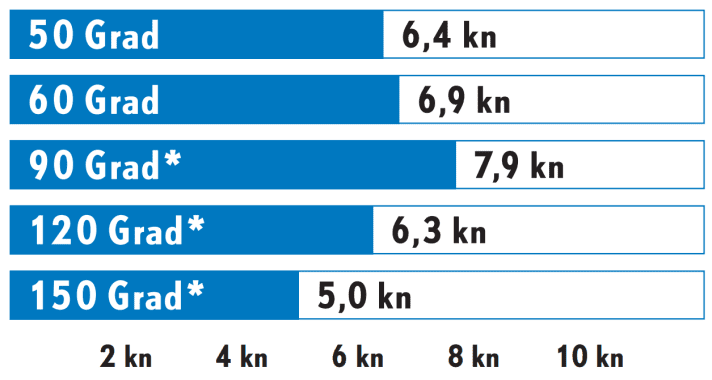
Wind speed: 15 kn (4 Bft.) Wave height: approx. 1.0 metres
* With Code Zero
Potential

The sail carrying capacity with self-tacking jib is rather low for a catamaran
1: Dimensionless number. Calculation: 2√S/3√V. The higher the value, the more sail area (S) the ship has in relation to the displacement (V).
Bunk mass
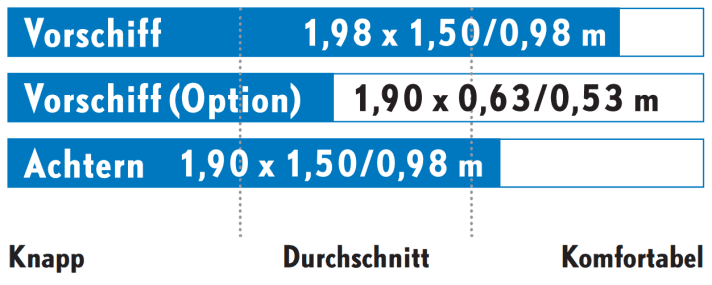
YACHT review Bali Catspace 40
A boat for the masses with maximum living space below deck and plenty of relaxation areas outside. The Catspace has sailing potential, but it needs wind. The range is also competitively priced
Design and concept
- + Fully compartmentalisable cockpit
- + Flybridge lounge and front cockpit
- - Visually rather clunky
Sailing performance and trim
- + Light and agile in the wind
- + Suitable for one-handed handling
- - Clearly under-rigged in light winds
Living and finishing quality
- + Plenty of space in the forward cabin too
- + Modern living ambience
- - Minor quality deficits in the expansion
Equipment and technology
- + Robust design, strong structures
- + Control also possible from the sat nav
Technical data Bali Catspace 40

- Design engineer: Lasta Design Studio
- CE design category: A
- Torso length: 11,80 m
- Width: 6,59 m
- Depth:1,10 m
- Weight:9,2 t
- Mast height above waterline: 18,23 m
- Mainsail: 52,0 m²
- Self-tacking jib: 30,0 m²
- machine (Yanmar):2x 20/30 hp
Hull and deck construction
Hull built from a mould using the vacuum infusion process with foam core. Deck: RTM injection
Base price ex shipyard
454,940 euros ex shipyard, gross incl. 19 % VAT (as of June 2023)
Shipyard and distribution
Bali Catamarans, Canet-en-Roussillon; www.bali-catamarans.com
Distribution via dealer network
This test appeared in YACHT issue 24/2020 and was revised by the editorial team in June 2023.

